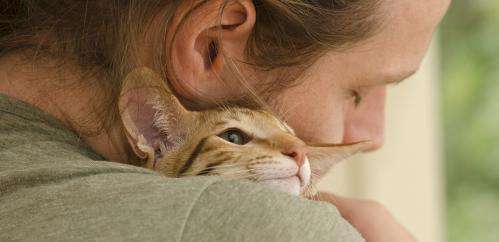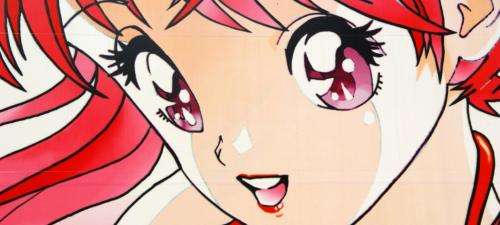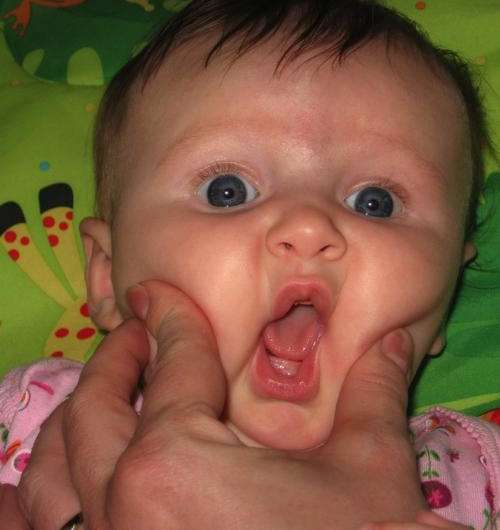Explainer: What is cute aggression?

Humans respond to cute. Show us just about any little critter with a big round head and a pair of large, blinking-in-the-headlights eyes and cooing will ensue.
Add to that a set of chubby cheeks, a button nose and teeny-tiny pursed lips and you're almost guaranteed to elicit clucking from the average adult.
The features of cuteness have been painstakingly mapped out and collectively are known as "kindenschema", "kawaii", or the baby schema. Their appeal is near universal, applying across geographical, cultural, and even species boundaries.
The enormous eyes and button noses of Japanese manga characters provide one of the most obvious examples of kawaii preferences manifesting in popular culture – as shown below.
Other manifestations are slightly more bizarre. The physical appearance of many domestic dogs, for example, is one consequence of our preference for the composite features of cuteness.
We humans have selectively bred youthful or pedomorphic characteristics into our canine companions to the point that the average adult Labrador looks far younger than a wolf of the same age.
Within human-to-human interactions, the consequences of baby schema preferences are significant.
A baby's cuteness is linked to the caregiving behaviour shown towards it. Specifically, adults are inclined to perceive an infant with exaggerated baby schema characteristics as being more desirable than those with less exaggerated features and are likely to pay more attention to such a child.
There are, of course, sex differences. While adult humans are equal in their abilities to discriminate the age and facial expressions of babies, research suggests only adult females are reliably able to discriminate between levels of cuteness.
Curiously enough, the cuteness quotient also has an impact in the opposite direction. Upon exposure to images of cuteness adult humans not only report feeling happier, but also show improvement in tasks involving fine motor control, improved attention span, and even increased levels of productivity.

Cute aggression
With all that in mind, a recent finding linking cuteness to a behaviour most commonly associated with negative societal outcomes – that of aggression – seems on first pass contradictory.
A team from Yale University reported that viewing images of critters high in baby schema characteristics inspires what appears to be observer aggression.
Specifically, observers were more likely to report wanting to say "grr" and squeeze the cutest of a range of different critters to which they were exposed. They were more also likely to pop bubble wrap – an indicator of aggression – when looking at them.
Despite its initial apparent contradiction with care-giving behaviours, this link to aggression has at least some intuitive appeal. Many of us have experienced the desire to almost literally squeeze the life out of something adorable, even if only as children.
Those childhood desires to squeeze a kitten tightly and pluck the eyes off a teddy bear are reflected in adult language: "you're so cute I want to eat you all up."
So why might cuteness elicit a combination of care-giving and aggression?
The Yale researchers suggest that aggressive tendencies manifesting in response to cuteness are a type of distorted outcome of the intense emotions elicited by cute things.
They speculate that frustration at not being able to satisfy the intense desire to care for the viewed object results in a type of violent response – a form of care-giving instinct gone feral.

Aggression and care-giving are both linked to neural processes mediating social behaviours. Baby schema activates the so-called mesocorticolimbic, or reward system.
It has been suggested the desire to approach and engage with objects that are cute is highly rewarding, releasing a quantity of dopamine into the brain cortex.
That is interesting because many of the same neural structures activated by cuteness are also activated when an individual is being aggressive. Indeed, it has been shown that the brain rewards aggression as it does other types of behaviours.
Perhaps the apparent aggression seen in response to cuteness is actually an exaggerated approach response mediated by the motivational aspects of both types of behaviours. If that is so, there should be a difference, at the neural level, between real and cute aggression.
Intriguingly, there is some precedent in other contexts for the brain to blend behaviours that are in most cases seemingly independent. Synaesthetes experience various (and to non-synaesthetes surprising) combinations of sensory experiences.
In one common manifestation, synaesthetes will experience numbers or letters as having inherent to them a particular colour. It has been shown that the neural mechanisms mediating those effects are higher-order, arising from activity in sites where colour and number and letter processes converge.
It may be that cute aggression is, in the same way, the integration of different responses to a single, very motivating, stimulus.
This story is published courtesy of The Conversation (under Creative Commons-Attribution/No derivatives).
![]()


















